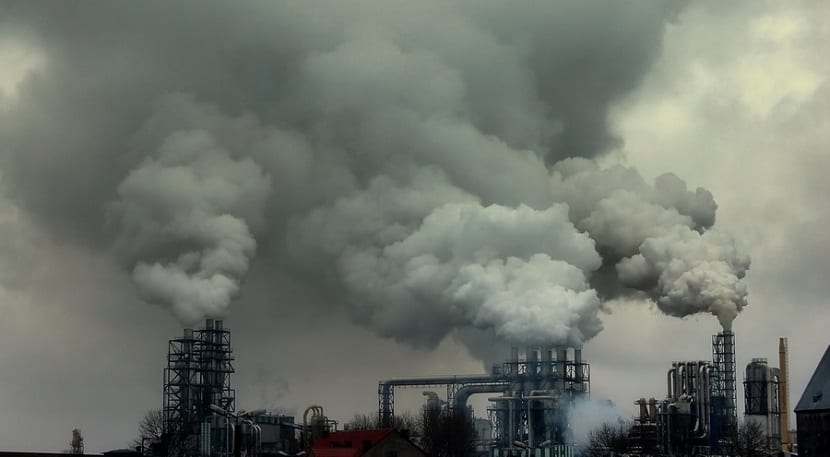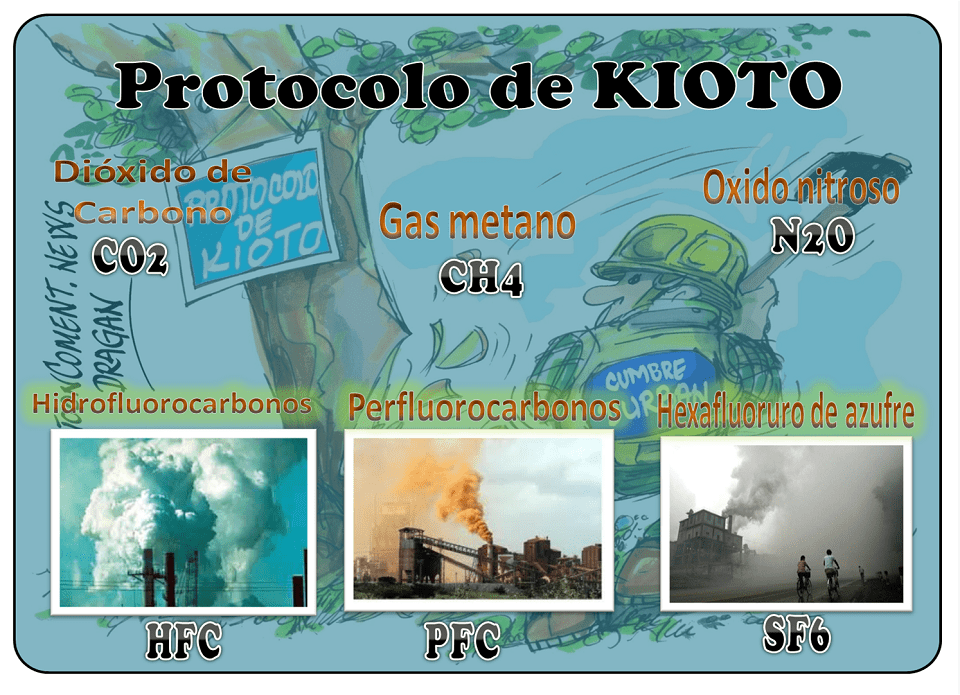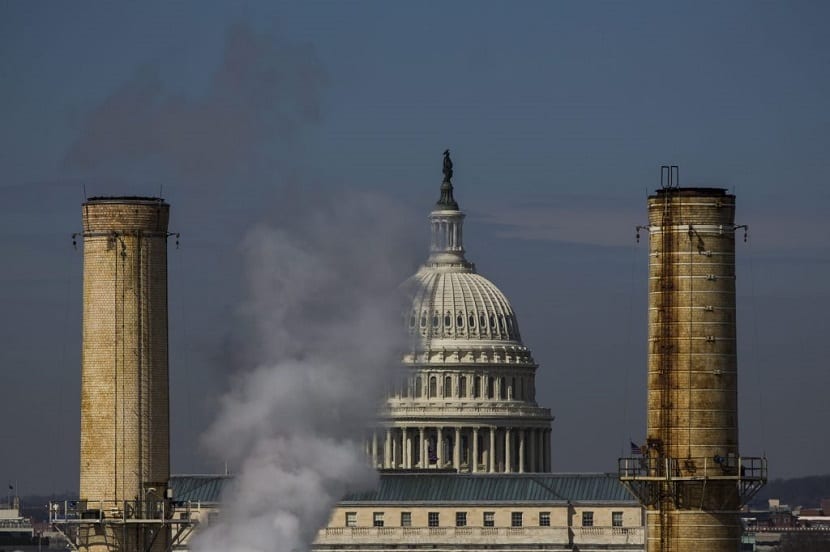
The concern for the conservation and protection of the environment is something that has emerged throughout the middle of the XNUMXth century. As the human being discovers that since the development of the industrial revolution he is degrading and destroying the planet, he realizes that he has to stop or slow down the patterns of exploitation of natural resources and reduce emissions and discharges to the atmosphere, water and soil.
Focusing on emissions to the atmosphere, the leaders of the countries that emit the most gases into the atmosphere create the so-called Kyoto Protocol to reduce them. What is the Kyoto Protocol and what is it trying to achieve? What period does it cover and what are its objectives?
The greenhouse effect and climate change

In order to understand what the Kyoto Protocol intends to stop, we have to introduce the serious effects and phenomena that our planet is suffering from emissions into the atmosphere derived from our economic activities. The first is the increase in the greenhouse effect. The so-called "greenhouse effect" consists of the rise in temperature of the planet caused by the action of a certain group of gases, some of them massively produced by man, which absorb infrared radiation, causing the earth's surface and the lower part of the surrounding atmospheric layer to heat up. It is thanks to this greenhouse effect that life on Earth is possible, since, if not for this, average temperatures would be around -88 degrees. Therefore, we should not confuse the greenhouse effect as an environmental problem, but rather its increase.
The increase in this greenhouse effect causes changes in the climate of the entire planet, since the systems of our world are not all the same or stable over time. This is known as climate change. The Kyoto Protocol arises to curb the increase in the greenhouse effect by reducing gas emissions into the atmosphere, and with it, avoid climate change.
The Kyoto Protocol

The Kyoto Protocol has been an important step towards a global regime to reduce greenhouse gas emissions into the atmosphere. It is an international agreement to avoid climate change in which all the countries that ratified it undertook to reduce their global gas emissions in their economic activities. It was approved in 1997 and it took a whole year for the member countries of the Framework Convention on Climate Change to decide that an agreement should be incorporated in which the strictest requirements were reflected in order to reduce gas emissions. greenhouse effect.
After some meetings, debates and discussions, the Convention entered into force in 1994. A year later, the governments began negotiations among themselves on an international agreement that would define the guidelines for emissions into the atmosphere of each country based on its economy. and production. This international treaty should function with its own autonomy. In the end, It was adopted unanimously in 1997 and entered into force in 2005.
What are the main objectives of the Kyoto Protocol?
The main objective of the Kyoto Protocol is to reduce greenhouse gas emissions for all those countries that have ratified it. These objectives depend fundamentally on the economic state in which the country is located. If the country is developing, it will be able to emit more greenhouse gases to improve its economy and production. On the other hand, a developed country with a good GDP will have to reduce its emissions, since it is more responsible than other countries with less emissions for the increase in the greenhouse effect.
The protocol's reduction targets range from -8% to + 10% of the emission level of the different countries in 1999 “with a view to reducing their total emissions of these gases to a lower level by no less than 5%. to 1990 in the commitment period between 2008 and 2012 ». We are talking about a 5% reduction in global gases in the most developed countries. However, each country depending on its economy will have to reduce emissions more or less with respect to the levels emitted in 1990. The European Union has to reduce 8%, 6% Canada, 7% USA (although it withdrew from the agreement), 6% in Hungary, Japan and Poland. New Zealand, Russia and Ukraine must stabilize their emissions, while Norway can increase them by up to 1%, Australia by 8% (subsequently withdrew its support for the Protocol) and Iceland by 10%. The EU has established its own internal agreement to reach its 8% target by distributing different percentages among its Member States. These targets range from cuts of 28% in Luxembourg and 21% in Denmark and Germany to an increase of 25% in Greece and 27% in Portugal.
Characteristics of the Kyoto Protocol
The countries that have ratified the Protocol have several ways of achieving the imposed targets that only by reducing emissions. For example, they can increase the number of "sinks" that remove greenhouse gases. With an increase in the area of forests, more carbon dioxide can be removed from the atmosphere. The Protocol gives flexibility to countries that this increase in sinks can be carried out in national territory or in other countries, since global emissions are taken into account.
Another way to achieve gas reduction targets is through emission rights trades. That is, the right of a country to emit one ton of greenhouse gas into the atmosphere. Countries can trade emission rights with each other. If a country has excess emission rights for emitting less, it can sell them to another country that needs to emit more to improve its economy.
The Kyoto Protocol is a complex agreement since it must not only be effective in the face of a global problem such as climate change, but also it must be politically acceptable and economically viable. These problems make the protocol progress very slowly and the objectives are not being fully met. The objectives are not binding, so any country could not meet them and not receive any type of sanction. In order to increase vigilance and compliance with the objectives, the number of groups and committees created to supervise and arbitrate its different programs has multiplied, even after the approval of the agreement in 1997.
Shortcomings of the Kyoto Protocol

The countries that ratify the Kyoto Protocol try to reduce greenhouse gas emissions to avoid not reaching an increase in global average temperatures above two degrees. The scientific community, after many studies on the climate and the effect of gases on it, managed to establish the limit of irreversible changes in all the ecosystems of the planet in a two degree increase in global temperatures. From there, the changes and negative effects on ecosystems would be devastating and irreversible for life as we know it.
For all these reasons, international treaties must try to strike a delicate balance. Those who seek general support are often not energetic enough to solve the problems they are trying to solve. In this case, the objectives of the Kyoto Protocol they are not ambitious enough to manage not to exceed two degrees of temperature rise.
Summary of the Kyoto Protocol
The main characteristics and objectives of the Kyoto Protocol are summarized here:
- It is a protocol of the United Nations Framework Convention on Climate Change (UNFCCC), and an international agreement that aims to reduce greenhouse gas emissions throughout the planet.
- The main gases that contribute to the greenhouse effect are six: carbon dioxide (CO2), methane gas (CH4) and nitrous oxide (N2O), and the other three are fluorinated industrial gases: hydrofluorocarbons (HFCs), perfluorocarbons (PFCs) and hexafluoride sulfur (SF6).
- The global percentage of gas reduction is 5% with respect to global emissions that existed in 1990.
- Not all countries that have ratified the protocol should reduce their emissions equally.
- The Kyoto Protocol was adopted in 1997 and entered into force in 2005.
- The gas reduction targets were achieved in the period from 2008 to 2012.
- The protocol is legally binding when no less than 55 countries have ratified it, including developed countries whose total emissions represented at least 55% of total carbon dioxide emissions in 1990.
- Countries can trade greenhouse gas emission rights.
- The Kyoto Protocol will definitively end in 2020 when the actions of the Paris Agreement begin to take place.
As you may have seen, the Kyoto Protocol is very complex. With this information you will be able to know a little more about this agreement against climate change, since it is fundamental for all of us and for that of our generations.
For this reason it is also important that countries take care of the planet:



